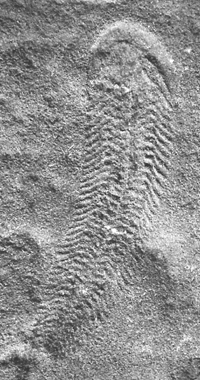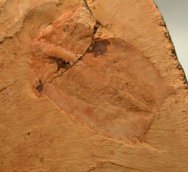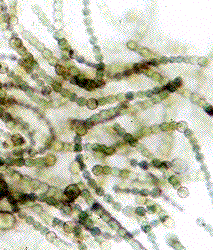There's no dust here. The Cambrian EXPLOSION is the worst denial of evolution we could conceive.
As you learned, there are vast numbers of fossils of Ediacarn fauna, with complex bodies, millions of years before the Cambrian. Some of them seem to have survived the development of fully-scleritized bodies (some Precambrian organisms had partially-scleritized bodies,so even that is transitional from earlier times) to produce some of the phyla in the Cambrian.
Barbarian is doing his best to moan that the soft nature of earlier fossils made them difficult to fossilise.
It did make it harder for them to fossilize, but they were distributed around the world in large numbers and so we have many fossils of them from many places in the world. Surprise.
The Cambrian fossil record includes an unusually high number of lagerstätten, which preserve soft tissues.
Most of these were quite similar to the sort of conditions that fossilized soft-bodied organisms in the Precambrian. There is also the "small shelly fauna", bits and pieces of partially-scleritized organisms from the Precambrian, in places where soft-bodied organisms would not have been preserved. Surprise, again.
He's managed to drag up some "pre-Cambrian" fossils.
Millions of them. World-wide.
What he doesn't seem to realise is that he now has to account for their existence, and their perfection.
Hardly perfect. In fact, they changed considerably over time, and into the Cambrian. But there's evidence for that, too. The first fossil cnidarians were small, simple blobs like some jellyfish, and did not move about. From that simple beginning, came all sorts of evolved jellies, corals, swimming cnidarians, etc.
There's no evolution there either.
Surprise.
Here's a nasty example:
They've found stromatolites - which are masses of cyanobacterial forms: which differ very little from the cyanobacteria of today!
Chapter 2 Insights into Cyanobacterial Evolution from Comparative Genomics
Wesley D. Swingley, Robert E. Blankenship and Jason Raymond
Recent high-throughput sequencing has provided DNA sequences at an unprecedented rate, posing considerable analytical challenges, but also offering insight into the genetic mechanisms of adaptation. Here we present a comparative genomics-based approach towards understanding the evolution of these mechanisms in cyanobacteria. Historically, systematic methods of defining morphological traits in cyanobacteria have posed a major barrier in reconstructing their true evolutionary history. The advent of protein, then DNA, sequencing - most notably the use of 16S rRNA as a molecular marker - helped circumvent this barrier and now forms the basis of our understanding of the history of life on Earth. However, these tools have proved insufficient for resolving relationships between closely related cyanobacterial species. The 24 cyanobacteria whose genomes are compared here occupy a wide variety of environmental niches and play major roles in global carbon and nitrogen cycles. By integrating phylogenetic data inferred for hundreds to nearly 1000 protein coding genes common to all or most cyanobacteria, we are able to reconstruct an evolutionary history of the entire phylum, establishing a framework for resolving how their metabolic and phenotypic diversity came about.
http://www.horizonpress.com/cyan
Yet another surprise for you. "Golly, they all look kinda the same" isn't a very smart way of classifying microbes.
1 They have chlorophyll: a massively advanced and complex substance, essential to the massively modern and complex process known as photosynthesis.
Turns out there that plants have, in each of their cells, these little bacteria-like things that contain chloropyll. These little things have their own, bacterial DNA, and reproduce independently of the plant cells, although neither the plant nor these organelles can now live apart from each other. It's called "endosymbiosis." The day is just full of surprises for you, isn't it? And there's more:
Those little endosymbionts (chloroplasts) have the ancestral chlorophyll a, but they have evolved an accessory pigment, chlorophyll b, which is not found in cyanobacteria.
How did these miserable, brainless bacteria figure that one out?
No need. Random mutation and natrural selection. Replace a CH3 group with a CH2OH group. Simple.
Evolution? Absolute bilge.
You're still assuming what you propose to prove.
2 They also have an enzyme system which fixes atmospheric nitrogen.
So do many bacteria and algae. But the system isn't that hard to do:
Front Microbiol. 2011; 2: 205.
An Alternative Path for the Evolution of Biological Nitrogen Fixation
Nitrogenase catalyzed nitrogen fixation is the process by which life converts dinitrogen gas into fixed nitrogen in the form of bioavailable ammonia. The most common form of nitrogenase today requires a complex metal cluster containing molybdenum (Mo), although alternative forms exist which contain vanadium (V) or only iron (Fe). It has been suggested that Mo-independent forms of nitrogenase (V and Fe) were responsible for N2 fixation on early Earth because oceans were Mo-depleted and Fe-rich. Phylogenetic- and structure-based examinations of multiple nitrogenase proteins suggest that such an evolutionary path is unlikely. Rather, our results indicate an evolutionary path whereby Mo-dependent nitrogenase emerged within the methanogenic archaea and then gave rise to the alternative forms suggesting that they arose later, perhaps in response to local Mo limitation. Structural inferences of nitrogenase proteins and related paralogs suggest that the ancestor of all nitrogenases had an open cavity capable of binding metal clusters which conferred reactivity. The evolution of the nitrogenase ancestor and its associated bound metal cluster was controlled by the availability of fixed nitrogen in combination with local environmental factors that influenced metal availability until a point in Earth’s geologic history where the most desirable metal, Mo, became sufficiently bioavailable to bring about and refine the solution (Mo-nitrogenase) we see perpetuated in extant biology.
And again... surprise.
What? Fixes atmospheric nitrogen???? Haber and Bosch got Nobels for producing a process which does just that. But that was in the late 19th or early 20th century!
Actually, we could do it much earlier, but doing it in a way that was cheaper than just using organic fertilizer, that took some time. It was long known how to oxidize elemental nitrogen.





 . Your post #105 has inspired a question in me!!! :dunno
. Your post #105 has inspired a question in me!!! :dunno 




